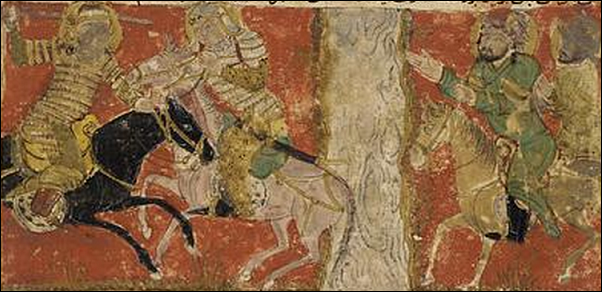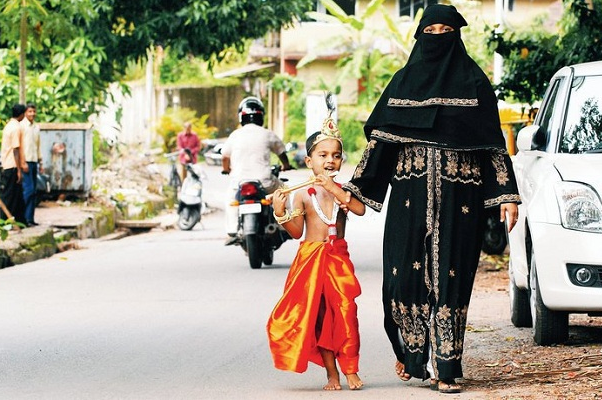[ by Charles Cameron — describing one of two books I am currently working on — your comments invited ]
.
I’m currently working on two book proposals for a publishing start-up a couple of friends of mine are putting together, and wanted to keep interested ZP readers informed. One proposal is titled Landmines in the Garden: religious violence and peace-making, and the other Coronation: the magic of monarchy. In this post, I want to say a little about landmines in the garden.
**
**
In what seems to have been my eighth guest post here at at Zenpundit, I introduced readers to the Duel of Ali ibn Abu Talib with Amru ibn Abd Wudd. It’s a story that interests me a great deal, appearing as it does in Muslim lore in Jalaluddin Rumi‘s Mathnawi among other sources — and with a variant form recounted by Joseph Campbell, who makes of it a Samurai story…
What I find so fascinating about the story as Rumi and others tell it is that is shows us what are called the “greater jihad” or struggle against one’s selfish nature happening in the context of the “lesser jihad” or war to defend the fledgling Muslim community. It is often claimed that the ahadith which depict these two jihads, with Muhammed obseerving that warriors returning from battle are returning from the lesser to the greater, are of late date and/or dubious provenance, and (tho no expert) I am inclined to accept that claim. Nevertheless, this story vividly illustrates the relation between them — and is one that has been used by Muslim sources more than once to restrain potential and wannabe jihadists from a foolish and dangerous impulse…
**
The story of the duel between Ali ibn Abu Talib and Amru ibn Abd Wudd is one in which a great Muslim warrior, Ali, interrupts an act of war (killing an enemy in the course of the “lesser jihad”) because he finds himself filled with angry pride (a condition that is unacceptable in terms of the “greater jihad” of the struggle for purity).
I find it striking that both the Muslim intellectuals / theologians of Ihasanic Intelligence, in “The Hijacked Caravan: Refuting Suicide Bombings as Martyrdom Operations in Contemporary Jihad Strategy” [p. 13], and the Muslim film-maker Kamran Pasha, in his episode of Sleeper Cell [Season 2 episode 4}, offer this tale of Ali and Amru as illustrating the erroneous thinking of AQ and its collowers.
I strongly recommend the sermon and subsequent discussion that Kamran Pasha puts into the mouth of his visiting Imam in that episode, which can be seen here:
— and note in particular how Pasha explicitly connects this story of Ali with the issue of the greater and lesser jihads.
If both the writers of a scholarly treatise and the writer of a popular television series use the same story to convince their fellow Muslims, it seems plausible that the story in question may in fact powerfully and appropriately serve such a purpose as deradicalization — while emanating from within the culture and context of Islam itself.
**
I shall be using that story as the narrative heart of my book, which will explore both religious violence and peace-making.
The cover I’d like for the book is this one, since it emphasizes the peaceable side of things — the terrorist side is only too clear, and in my view requires balancing from the side of the peace-makers:
My over-arching theme will be that religions offer us Pardes, Paradise, Firdaws — a garden or orchard of peace — but that buried within their scriptures and narratives there are texts which, if triggered, can be interpretetd as offering divine or transcendent sanction for violence — hence, landmines in the garden.
I am all for the identification and avoidance of landmines.
**
Here, then, is my “executive summary” for the book:
War and peace are getting more, not less, religious as we move from the second into the third millennium.
Somewhat to the surprise of those who felt sure the world was growing ever more secular as time went on and the marvels of science and technology prevailed over myth and magic, it seems as though religion is enjoying an upswing — and while this might seem no more than a mild sociological curiosity for many of us, for those concerned with threats to national and international security and peace, it’s a major problem.
And it’s a far more intractable problem than it needs to be, because we have a blind-spot with regard to religious violence: we either don’t see it at all, thinking it’s all just politics as usual, wearing a religious mask — or we think it’s all religion’s fault, or all the fault of one religion in particular — someone else’s religion, one we don’t much like at all. What we don’t see is the whole picture.
There are robust industries proclaiming that religion is responsible for all the woes of our times, and that Islam is responsible for terrorism in particular — and a powerful lobby, backed by US presidents of both parties, that argues that Islam is a religion of peace and that al-Qaida and its offshoots have “hijacked” that peaceable religion for purely political reasons.
In truth al-Qaida is but one expression of Islam — a religion as widespread and diverse across centuries and continents as Christianity or Buddhism — but by no means representative of all that Islam has to offer the world.
In this book, we shall explore the strands of violence, warfare and terrorism to be found across all the major religions — Buddhist killings of Muslims in Myanmar, Sikh separatist assassinations in India, Christian vs Muslim militias in Africa (with touches of cannibalism on both sides), Hindu mobs razing a Muslim temple, Jews attacking the al-Aqsa Mosque in Jerusalem and the Cave of the Patriarchs in Hebron… and the call, in each of these religions, for moderation and peace.
Christian contemplatives, Islamic Sufis, Taoist masters, Hindu yogis, Tibetan lamas, and Jewish mystics find common cause in a self-surrender to a power greater than themselves, a power which offers love as its highest goal, seeks justice balanced with mercy, and has compassion as its practical expression in the world. These religions do not merely teach peace, they show us how to find it in ourselves, and how to practice it in our lives.
The great and glorious beauties that the various religions have brought into this world offer us fruits of that contemplative love, foretastes of the Garden, the Paradise all religions proclaim. But there are landmines in that Garden. If we are to come to grips with the perils of religious terrorism and hate, we must understand religion’s potential for both violence and peace.
My book will refute the myths, expands our horizons, and offer reconciliation, beauty and hope.
**
Your comments and suggestions for the book are most welcome.




